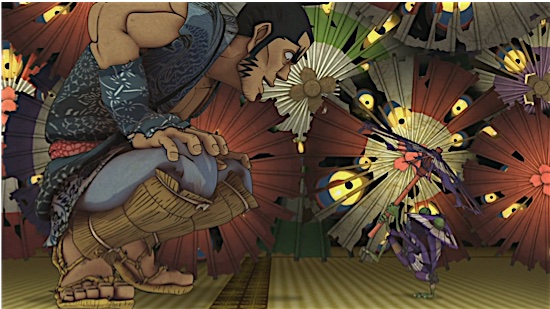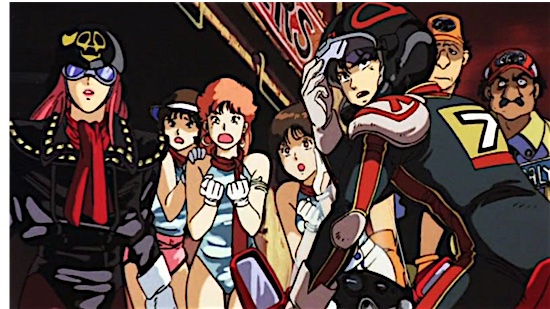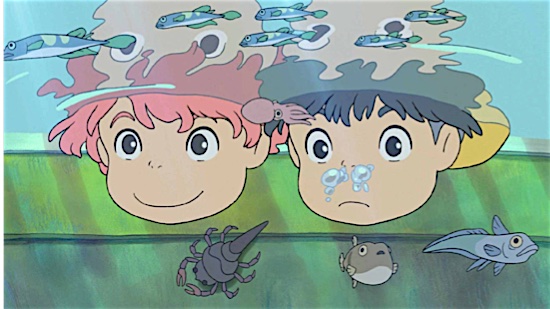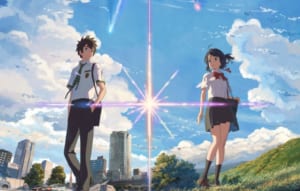7- The Best Anime Movies of All Time
7- The Best Anime Movies of All Time
89. Short Peace (2013)
Director: Various

A multimedia project consisting of four animated shorts plus one videogame, each representing a different period in Japan’s history, Short Peace is a delightful grab bag. With Otomo at the helm guiding the project, and providing one of the shorts, this project pulled together a ton of talent, all in the service of some gorgeous animated short films. The unifying concept barely hangs together, but each of the tales are so singular and stunningly rendered, this is a minor concern. The most singular of the bunch is “Possessions,” was nominated for an Oscar, and it’s easy to see wh
The visual technique and seamless rendering of CG/2D animation is absolutely captivating. Otomo’s own contribution, “A Farewell to Weapons,” based on his manga, is the other centerpiece and closes out the collection. It remains true to many of Otomo’s extant themes—mainly, the effects of technology on humanity, and the inability of man to escape his patterns of tribal violence and conquest. The designs are incredibly detailed and well-thought out, like all of Otomo’s work
and the animation is of course hyper realistic. Overall, Short Peace is an excellent modern entry in the hallowed tradition of great collections of anime short films, even if the feast it provides is a bit more for the eyes than the brain. —J.D
88. Momotaro: Umi No Shinpei (1945)
Director: Mitsuyo Seo
Long before Tezuka Osamu laid the foundation for the signature aesthetic behind anime and the medium’s stylistic maturation in the mid-’80s opposite its ascendancy as a global cultural export, the roots of modern japanese animation were born from format in which most if not all animation originated in the early 20th century: as propaganda films created in order to win hearts and minds and spur their respective nation’s youth to take up arms and fight for, what was at the time thought to be
“the good fight.” Momotaro: Umi No Shinpei, known to western audiences as Momotaro’s Divine Sea Warriors, holds the distinction of being the first feature-length animated film produced in Japan. Believed lost for decades before being rediscovered in 1984, Momotaro is invaluable touchstone in the history of Japanese animation, transporting viewers back to a time of startlingly different attitudes and sensibilities.
87. Venus Wars (1989)
Director: Yoshikazu Yasuhiko

Adapted from Yoshikazu Yasuhiko’s own original manga series in 1989, Venus Wars is a spectacular sci-fi action war film filled with terrific animation, surprising depth, and a delightfully hammy soundtrack courtesy of Joe Hisaishi. Taking place on, you guessed, the second planet in the solar system nearly seventy following a terraforming event, Venus Wars follows a group of teenage monobike racers-turned-freedom fighters after their home of Aphrodia is occupied by the forces of Ishtar
their neighboring rival to the North. With mechanical designs courtesy of Makoto Kobayashi, a notable experimental use of live-action footage to simulate Venus’ barren terrain, and a creative staff that consists of a veritable “who’s who” of 1980s anime icons, including character designer Toshihiro Kawamoto of Cowboy Bebop fame, Venus Wars is a memorable film that delivers as a pulp sci-fi adventure on a visual level but manages to be a thoughtful exploration of what it means to watch one’s home transformed into a police state during a time of war
86. The Cat Returns (2002)
Director: Hiroyuki Morita
A spiritual successor-of-sorts to Yoshifumi Kondo’s Whisper of the Heart, The Cat Returns is a playful romp that combines Studio Ghibli’s signature brand of magical realism imbued with a fresh perspective courtesy of director Hiroyuki Morita. When Haru Yoshioka, a shy and absent-minded schoolgirl, rescues a mysterious cat while on her way home from school, she realizes she possesses the latent ability to talk to cats. Her life is then turned upside down as the cat’s father
the king of cats, showers her in bizarre tokens of gratitude and orders her betrothal to his son as “reward” for her kindness. It’s then up to her seek out the fabled Bureau of Cats to find the one person who might be able to save her: the dashing gentleman-noble Baron Humbert von Gikkingen. Naoya Tanaka’s art direction and Satoko Morikawa’s character designs are the real draw that distinguish the film’s look and feel, and with a simple yet whimsical story built around likable personalities and beautiful settings, The Cat Returns easily warrants mention alongside Studio Ghibli’s very best
85. Giovanni’s Island (2014)
Director: Mizuho Nishikubo

One of the most appreciable qualities of Japanese animation is the readiness in which they are willing to relate and contextualize their history as a country and as a people through a medium which is too often looked down upon as inherently trite and childish. Case in point: Giovanni’s Island. Set in the aftermath of World War II, the film follows the stories of Junpei and Kanta, two young boys whose home island of Shikotan is quickly occupied by Soviet allied forces in the wake of Japan’s surrender
. As their world is irrevocably by the intrusive hardships and indignities of the real world, the boy grasp to a solitary thread of hope through their imaginative love of Kenji Miyazawa’s novella Night on the Galactic Railroad, a book from which their names are inspired. Directed by Mizuho Nishikubo, who served as the esteemed animation director of Oshii’s Patlabor 2, the film touts simplistic though beautifully expressive character designs and dynamic settings featuring distinctive jagged outlines and shadows. The film’s fantasy sections are wonderful as a well
rendering the allusions to Miyazawa’s novella with such modern imaginative fidelity that it easily sits beside that of Gisaburo Sugii’s masterful 1985 adaptation. Akin to Takahata’s Grave of the Fireflies, Giovanni’s Island is an affirming if tragic story of the resilience of a family living through the end of a World War, but it’s also something all its own. It’s a story of the intrinsic human persistence to forge connections and friendships in the face of seemingly unassailable differences. An excellent film about history, family, language, and hope
84. Sweat Punch (2007)
Director: Mizuho Nishikubo
Sweat Punch is a curious beast that’s a bit hard to track down, but worth the effort. Comprising five animated shorts originally released as a part of Grasshoppa! DVD magazine issues, they were then collected into one release titled Deep Imagination. Deep, indeed, would be one way to describe these shorts, which range across the map both in style and subject matter
The first, “Professor Dan Petory’s Blues,” doesn’t really try to make sense, and is content to simply throw all kinds of wild animation techniques in a blender with some songs and jokes, to kaleidoscopic effect. It only gets weirder from there. “The End of The World” is another standout, concerning the life of a young alien girl named Yuko, who meets a friend at a rock concert, then proceed to go back to her home planet and battle with S&M monsters (no, really). A third, confusingly entitled “Comedy” by Studio 4C, is a dark, gothic tale verging on horror that concerns a young girl, a master swordsman, and the Irish War of Independence.
Most of these shorts break not only from traditional narrative, but also from traditional anime art style and animation techniques. These are animation in its purest form, the directors and animators involved clearly just enjoying the riot of color and movement they present to the viewer. It’s pointless to try to explain more, really. Sweat Punch must be seen to be believed, and “understanding” it might be beside the point. —J.D
83. Cowboy Bebop: Knockin’ on Heaven’s Door (2001)
Director: Shinichiro Watanabe

When Cowboy Bebop first premiered in North America on Adult Swim in September of 2001, it was one of the great defining moments of anime securing its cultural foothold in the West. Set in the year 2071, Cowboy Bebop was many things: a sci-fi western noir character drama built around the themes of existentialism, identity and loneliness. But above all else it was a master course in cinematic evocation, channeling the ineffable cool of turn-of-the-century jazz, rock ’n’ roll
and film noir and transforming it into something that was unlike anything that had come before or since. With a script penned by Keiko Nobumoto, a score by the inimitable Yoko Kanno, action scenes framed and choreographed by Yutaka Nakamura, and series’ director Shinichiro Watanabe returning at the helm, Knockin’ on Heaven’s Door is the anime equivalent of a seminal band getting back together for one last farewell tour after ending off on a high-note and a bang
82. Genius Party (2007)
Director: Various
If you’re looking for a collection of some of the most eccentric, colorful, and unique animated shorts from some of the most preeminent anime directors working today, you can’t go wrong with Genius Party. Released in 2007, the film serves the purpose of what any good anthology should—putting supremely talented animators on a project and allowing them to throw whatever they want at the wall. And that’s what it succeeds as a whole in doing—to varying degrees of individual success, of course. Shoji Kawamori’s “Shanghai Dragon” is a wild free-wheeling take on Super Sentai hero antics
Yoji Fukuyama’s “Doorbell” is a unsettling and confounding psychological thriller, and Shinji Kimura’s “Deathtic 4” is a bizarre 3D-animated short that’s sure to play well for Tim Burton fans on an aesthetic level. The only dud in this collection is Hideki Futamura’s “Limit Cycle,” which, although having one of the most unique art styles of the bunch, meanders in pop-scientific pontification and pretentious navel-gazing. The crowning jewels of the collection however are Masaaki Yuasa’s
“Happy Machine” and Shinichiro Watanabe’s “Baby Blue,” which each exemplify the best defining talents of their respective creators. All in all, Genius Party is a stunning collection of shorts produced by one of the most eclectic production studios operating today and should not be missed
81. Summer Wars (2009)
Director: Mamoru Hosoda

Summer Wars is pretty much a beat-for-beat remake of Hosoda’s previous work on the second Digimon film, Our War Game, released in 2000. However, when a film is this well-animated and put together, the accusation of unoriginality can be forgiven. Summer Wars is the story of Kenji Koiso, a shy and unassuming math prodigy who works as an admin assistant for OZ, a massive digital network that’s supplanted the internet as the major connective system across the world
When Kenji’s OZ avatar is hijacked by Love Machine, a sentient computer virus hell bent on throwing the entire planet into chaos, it’s up to him and the extended family of his fake girlfriend Natsuki (long story) to band together and go to war. OZ resembles a psychedelic “superflat” dreamscape à la Takashi Murakami thanks to Anri Jojo’s art design
and with impeccable character art by the likes of Gainax veteran Yoshiyuki Sadamoto, Masaru Hamada, and Takashi and Mina Okazaki, Summer Wars is an engrossing big family drama with heart couched inside a candy-coated “Internet of Things” scenario of catastrophic proportions.
80. A Wind Named Amnesia (1990)
Director: Kazuo Yamazaki
On the eve of the 21st century, the collective memory of every living being on Earth was wiped by an inexplicable mass phenomenon, decimating civilization and reducing the human race to roving tribes of scavengers devoid of language, reason or technology. Wataru, a survivor of this worldwide amnesia meets Sophia, a mysterious young woman seemingly unaffected by this worldwide epidemic
The two embark on a journey across the heartland of America in search of answers not only to the question of what caused humanity’s downfall, but what it means to be a human being at all. The film’s animation definitely shows its age in some respects, and when it comes to the thematic ambitions of its subject matter versus its narrative execution its reach more often than not exceeds its grasp
but A Wind Named Amnesia remains a thought-provoking movie and an understated gem in rough of early ’80s animation. Word to the wise: steer clear of the English dub, as it dispels most of the film’s nuance and subtext in lieu of playing it up as a comparatively hollow action adventure
79. Ponyo (2008)
Director: Hayao Miyazaki

Of Hayao Miyazaki’s eclectic and universally renowned body of work, Ponyo is arguably his strangest. A modern reinterpretation of Hans Christian Andersen’s 1837 The Little Mermaid, Ponyo couldn’t be further from an attempt to compete, let alone eclipse Disney’s award-winning 1989 adaptation. Instead, Miyazaki eschews anthropomorphic crabs and garish musical numbers in favor of honing in on the love story between a young boy and a girl-fish who yearns to be human
The film’s aesthetic is straight of out of child’s picture books, with thick solid shapes framed by beautiful bright primary colors. It’s a trippy, kid-friendly film that manages to pack in a surprising amount of thematically heady material with regards to environmentalism and the delicate balancing act between humanity and nature. Ponyo certainly is not anywhere near Miyazaki’s best, but it unquestionably stands among the medium’s best
78. Evangelion: 1.0 You Are (Not) Alone (2007)
Director: Hideaki Anno, Kazuya Tsurumaki, Masayuki
If you’re an anime fan and have never watched the original Neon Genesis Evangelion, you are likely no more than three degrees separated from someone who has a passionate opinion about it, effusive or otherwise. What began as a 26-episode television series produced by Gainax and directed by Hideaki Anno quickly morphed into nothing short of a cultural phenomenon within the sphere of anime, thanks in huge part to the show’s unmistakable mecha designs, inspired animation, iconic character designs, and a plot that was equal parts harrowing, esoteric, and uncompromisingly meta
Released as the first installment in Anno’s Rebuild of Evangelion tetralogy, Evangelion: 1.0 You Are (Not) Alone is essentially a shot-for-shot high-definition remake of the first six episodes of the original series, albeit condensed to the length of a standard feature and filled with new designs and animation. Whether you’ve watch the series when it first aired or are curious to see just what all the hubbub is about, Evangelion: 1.0 You Are (Not) Alone is a fantastic introduction to one of the most celebrated and divisive animes of the late 20th century

